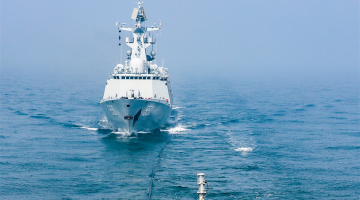By Ding Jiayou and Yang Haining
Japan has recently made frequent moves in the military field. It officially approved the installation of two land-based Aegis Ashore missile defense systems from the US, later transformed the "Izumo" helicopter destroyer into an aircraft carrier, and also reached out to space and other fields.
The Japanese government has decided to set up a command center at the Defense Ministry to deal with threats in space and cyberspace as well as electronic warfare and the plan will be included in the National Defense Program Guidelines that the government will update in late 2018, according to Japanese media reports.
At present, the senior command organs under Japan's Self-Defense Forces mainly include the three major command organizations of the land corps, the self-defense fleet and the aviation corps.
The reports revealed that the new command center is on the same level as the land corps. Therefore, it is entirely reasonable to regard the "space, cyberspace and electronic warfare" force as a new force that aligned with the Japanese land, maritime and aviation Self-Defense Forces.
In fact, Japan has a certain level of capability in space, cyberspace and electronic warfare.
For example, Japan has gradually developed a complete force system in space surveillance, reconnaissance and communications. It also plans to launch the "Optical 6" reconnaissance satellite in February this year. Japan established a cyber defense team in as early as 2014.
All types of surface ships of the Japanese Maritime Self-Defense Forces are equipped with electronic jamming systems such as radar jamming systems and chaff / infrared decoy launching systems.
The only difference is that the powers in these three areas are separate and there is not one united leading organization.
Therefore, Japan wants to unify the military powers in these three areas by establishing the "space, cyberspace and electronic warfare" command and integrate the force with its regular military power to form comprehensive military advantage.
Besides, Japan also wants to enhance the level of the Japan-US alliance.
During his talks with US President Donald Trump in November 2017, Japanese Prime Minister Shinzo Abe said that he will enhance cooperation in the field of space and Japan will also participate in the US space Schriever drill.
Under such circumstances, if Japan can integrate the forces in the fields of space, cyberspace and electronic warfare, it will be able to deeply fit in all kinds of relevant US drills and deepen the cooperation between Japan and the US.
It should be pointed out that the intention to set up the "space, cyberspace and electronic warfare" command is yet another step towards Japan's "normalization of the military," as well as an attempt to break the "purely defensive defense"and the "Peace Constitution."
Abe held the first press conference for the New Year on Jan. 4 and proposed the issue of an amendment to the constitution once more.
Under the background of Japan's right-wing denial and beautification of the history of aggression, any move by Japan in the military field can easily lead to turmoil in the region and therefore the international community should keep a close eye for Japan.









